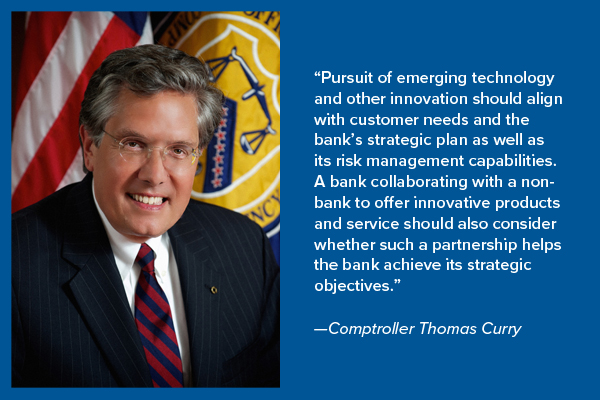OCC would balance innovation against risk
Innovation labors under shadow of financial crisis, but Comptroller sees need to adapt
- |
- Written by Steve Cocheo
 The Comptroller's Office understands that banks must innovate to survive, but wants to see "responsible innovation" that balances risks and results.
The Comptroller's Office understands that banks must innovate to survive, but wants to see "responsible innovation" that balances risks and results.
Can federal banking regulators find a middle way between strict prudential supervision and financial services innovation? Or is it wrong to think of these as extremes?
The Comptroller’s Office has set out a preliminary framework for addressing this that itself poses as many questions as it answers.
In a speech at a Harvard University conference on March 31, Comptroller of the Currency Thomas Curry spoke of the need to recognize the need for innovation, both in terms of serving customers as well as to keep banks of all sizes competitive.
But throughout his speech Curry repeatedly spoke of the need for innovation to be “responsible innovation”—his term. Curry called for innovating “in a thoughtful and responsible way that guards against risk to consumers and threats to the financial system.”
Light bulb or darkness?
The regulated banking industry clearly has inherited a shadow from the Great Recession.
“Recalling the lessons of the financial crisis, when some ‘innovative’ products such as subprime mortgages and financially engineered securitizations were used in ways that had disastrous consequences for individuals, communities, and our economy, we want to be sure that the banks and thrifts we supervise innovate in a way that is compatible with safety and soundness and consistent with consumer protection laws and regulations,” said Curry. “In short, what we are trying to encourage is responsible innovation.”
What does that term mean? Concurrent with Curry’s speech his agency released a white paper, “Supporting Responsible Innovation in the Federal Banking System: An OCC Perspective.”
The short document contains a succinct definition:
“The use of new or improved financial products, services, and processes to meet the evolving needs of consumers, businesses, and communities in a manner that is consistent with sound risk management and is aligned with the bank’s overall business strategy.”
Regarding the last point, the white paper urged a balanced attitude towards innovation:
“A bank’s decision to offer innovative products and services should be consistent with the bank’s long-term business plan rather than following the latest fad or industry trend,” it stated. “Pursuit of emerging technology and other innovation should align with customer needs and the bank’s strategic plan as well as its risk management capabilities. A bank collaborating with a nonbank to offer innovative products and service should also consider whether such a partnership helps the bank achieve its strategic objectives.”
Curry referred often to the value of traditional banking by regulated financial institutions, often mentioning the importance of community banks. He made a point that innovation didn’t necessarily only involve digital services, that innovative product design—including serving the needs of the unbanked and underbanked—was also part of the picture.
And Curry added one more raised eyebrow to increasing federal attention to marketplace lenders—the Consumer Financial Protection Bureau recently announced that it would add such players to its public complaints process and the Treasury Department has been studying that business. CFPB recently published a consumer guide to such lenders.
“Our job is to help ensure that banks of all sizes are capable of withstanding economic storms so that they can continue to support their communities and their customers,” said Curry. “I would worry about the staying power of some of the new types of lenders. One of the great virtues of community banks is that they know their customers and they stand behind them in good times and bad. I’m not so sure that customers selected by an algorithm would fare as well in a downturn.”
Curry noted that banks, through innovation labs and similar efforts, have been trying to design new services. He added that nonbank players have been inquiring about banking charters. He said he was concerned about national banking charters being granted without the safeguards and responsibilities that apply to chartered banks and savings institutions.
Framework for “responsible innovation”
In the speech and the white paper, the changing patterns in financial services wrought by fintech and other nonbank players was recognized. While the trend towards digital banking was recognized, the agency noted in the white paper that traditional banking retains much value that digital banking could build on.
“Brick-and-mortar branches are a stabilizing force in low-income neighborhoods,” the paper states, “and innovative technology should not be seen as a substitute for a physical presence in those communities.” However, digital tools could help such consumers, the paper indicated, with cited examples including online and mobile banking, saving, budgeting, and financial management tools.
While attention to risk issues and fairness in banking dominated much of the speech and the paper, Curry noted that his agency sees the need to not stand in the way of innovation while maintaining oversight and involvement in financial services evolution.

“Not every innovation is appropriate for a regulated financial institution, and not every innovation that is appropriate for a regulated institution is appropriate for all regulated institutions,” Curry said. “But avoiding new approaches completely is equally dangerous.”
Banks must continuously adapt, Curry said. In addition, he said, regulators “have to be knowledgeable enough to understand new technology and nimble enough to render timely decisions on matters requiring regulatory approval, as well as guidance about our supervisory expectations.”
The white paper sets out a proposed eight-point plan that would move the agency towards a balanced approach
OCC’s ideas for regulatory innovation oversight
Curry acknowledged, in releasing the white paper, that the industry as well as fintech players “might view us as inhospitable to innovation.”
“After all,” he continued, “innovation is not risk free. But it can be managed, and we want to foster an internal culture that is receptive to new technology and new ways of doing business.” He noted that in the course of obtaining input from OCC staff, a strong interest in greater involvement in innovation was found.
Both banks and nonbanks consulted in the course of developing the white paper told the agency that they want greater clarity as partnerships and alliances between traditional and nontraditional organizations are studied.
In brief, here are the elements that OCC has been considering and seeks public input on:
1. Support responsible innovation. Streamlined and expedited review of ideas is being looked at, in the context of risk management. One possible step: creation of a central “office on innovation.”
2. Fostering an internal culture at OCC receptive to responsible innovation. The paper notes that the agency has already assembled internal working groups on payments innovation and marketplace lending.
3. Leverage agency experience and expertise. OCC will consider designating internal “lead experts” on innovation to support supervisory efforts. This would build on existing lead expert efforts in retail and commercial credit, compliance, bank information technology, and more.
4. Encourage responsible innovation that provides fair access to financial services and fair treatment of consumers. One proposed effort would be OCC serving as a clearinghouse of “success stories” in increasing access to unbanked and underbanked consumers; improving speed, efficiency, and transparency of transactions; and finding better ways to lend and invest in ways to meet credit needs of low- and moderate-income people and communities.
5. Further safe and sound operations through effective risk management. This effort would build on existing OCC efforts to identify all kinds of risk, from cyber risks to credit exposures.
6. Encourage banks of all sizes to integrate responsible innovation into their strategic planning. Beyond the tie-in mentioned earlier between innovation and strategy, this effort would augment longstanding general admonishment to address risks of banking activities through governance, risk management, and more.
7. Promote ongoing dialogue through formal outreach. This would involve continuing communication with banks, nonbank innovators, and consumer groups.
8. Collaborate with other regulators. Among the elements of this point is this: “Use best efforts to avoid inconsistent communications with supervised entities.”
Tagged under Management, Risk Management, CSuite, Operational Risk,













